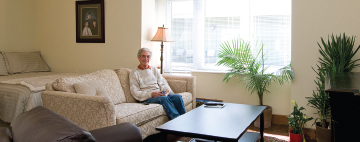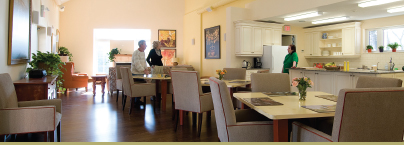Abbeyfield House: Hearth and Home
It is no secret that the enjoyment of good food and good company creates lasting social and emotional benefits.
The only certainty in life is that time marches on. The young become the old. One day the garden seems too large, the snow too heavy, the staircase too steep, driving is confusing and preparing dinner too much effort. What happens then?
One spanking-new answer is Abbeyfield House in Caledon East, a family-style home for twelve seniors that offers a mix of privacy, companionship, security and independence.
Abbeyfield’s first resident, Ken Gane, moved in October 1. Ken used to live just outside Caledon East in the house where his daughter and her family now reside and his son lives in the village.
Since his retirement from management at Litton Industries in Rexdale, Ken and his wife, Diane, had lived out of the area in two successive “adult lifestyle” communities, most recently at Tottenham’s Tecumseth Pines. But that ended when health problems necessitated Diane’s move into a long-term care facility. Now on his own, Ken, 79, has returned to Caledon East, closer to his children and back to the community he still called home.

Top of page: Gail Grant outside Abbeyfield House: “We want light, we want air, we want high ceilings.”Above: Ken Gane relaxes in his bed-sitting room, where a large window looks over the garden and floods his room with natural light.
“I was in the hardware store the other day,” Ken says, “and met some people I’d known years ago. They just about fell over to see me again!”
Abbeyfield is an international society dedicated to providing healthy, active seniors with affordable housing within their local community. Gail Grant, vice-president of the volunteer board of directors, has been involved with the Caledon project since its inception.
“People who have spent their entire lives here were being forced to move away,” Gail says. “It didn’t seem right. They help to build this community and then they get to this stage in their lives and have nowhere to go.”
During the building design process, the board was continually telling the architect, “Please, please, please don’t give us long dark corridors,” Gail recalls. “We want light, we want air, we want high ceilings.”
And indeed that is what they received. The 10,000-square-foot building is anything but institutional. Its glistening dark hardwood floors, cream walls and lots and lots of windows give a sense of spaciousness without being overwhelming. The residents’ bed-sitting rooms are in two pods, with each six-room pod circling one of many cozy sitting areas throughout the building. Washrooms are all “aging-in-place” size, large enough to accommodate a wheelchair or walker. With heated floors, individually controlled heating and air conditioning, large energy-efficient windows that open onto gardens and courtyard, and a covered verandah, the building exudes state-of-the-art comfort.
“Each resident has a private room, but they eat and do other things communally,” Gail says. “What we are trying to recreate here is the feeling of a family where residents support each other, know each other, and can become buddies.”
Although the Abbeyfield model is for singles, Gail says couples could be accommodated. The important factor is that residents must be able to live independently – able to clean their own rooms and do their own laundry, for example. “We don’t dispense meds or offer help with bathing, but there are agencies that can come in to do that if the family thinks it is becoming necessary.”
Combatting loneliness and isolation is one of Abbeyfield’s main goals. Even in a seniors’ development where people live in single-family homes or self-contained apartments, they can become isolated. In rural communities such as Headwaters, there are many elderly people living alone on the family farm in the middle of 100 acres. Abbeyfield provides the missing option for independent, but solitary seniors who seek companionship but do not require long-term care.
Serendipitously, Gail attended the opening of Hospice Caledon’s Bethell House in Inglewood when Abbeyfield was about two-thirds completed. On seeing the hospice’s warm and inviting interiors, she asked interior designer Rafe Bethell, donor Lorna Bethell’s son, to furnish Abbeyfield as well. “He did a fantastic job and knew exactly what we needed.”
Many local businesses and individuals also stepped up to help Abbey-field get on its feet. Palgrave Rotary, for example, installed lockers for the residents to store overflow or seasonal belongings. And the library/common room will soon boast a wide-screen TV thanks to a donation from a local resident.
The Abbeyfield concept came about in 1956 in the London Borough of Bermondsey, England when Major Richard Carr-Gomm resigned his commission with the British Army’s Coldstream Guards and bought a run-down, six-room property with an outdoor lavatory and two cold taps. He renovated the house to provide housing for four people – the only required qualification was loneliness. Major Carr-Gomm was the house-keeper and became known as “The Scrubbing Major.”
Today there are 1,100 houses world-wide, serving over 9,000 residents. Abbeyfield Houses Society of Canada was established in 1984; its first house opened in Sidney, BC in 1987. There are now forty member societies in Canada with thirty houses in operation or under construction.
Each Abbeyfield house is unique with no standard building plan. Gail was surprised to find one when she was holidaying near Ajijic, Mexico. “Someone had bequeathed a pretty house right on Lake Chapala to Abbeyfield,” Gail says.
That house was renovated with room for four private units and four more casitas (little houses) were built on the spacious grounds. According to its website, several residents in their nineties are happily living there.
Abbeyfield Houses are set up on a not-for-profit basis with a volunteer board of directors and a salaried live-in house manager who provides meals, looks after the house and generally cares for the residents.
“The Abbeyfield concept totals up what it costs to run this place and to pay down the mortgage, pay the house manager, food, insurance, heat, the whole package – and then divides it by the number of residents,” Gail says. The monthly occupancy cost works out to $1,800 per resident, consider-ably less than private residences of the same quality.
Abbeyfield Caledon’s house manager is Gillian Depass, a 60-year-old ball of fire who has been in the food industry for years. Most recently she cooked for 160 seniors at a large long-term care facility in Richmond Hill. Now, with a maximum of twelve residents at Abbeyfield, she is looking forward to being able to personalize meals.

The large kitchen provides a cheerful gathering place where house manager Gillian Depass (right) serves up delicious and nutritious meals.
Residents help themselves to breakfast in the kitchen, but Gillian prepares their nutritious lunch and dinner.
“Gillian has great versatility with the menus,” Ken Gane says. “I’ve never known anything like that in my life.”
Small and wiry, Ken laughingly says he’s already put on a couple pounds since moving in and will soon need to buy a new wardrobe. If the chicken Caesar salad and cheesecake with fresh berries we had for lunch the day I visited is any example of Gillian’s skills, Ken might be closer to the truth than he knows.
Nutritious meals are integral to maintaining the health and strength of the residents. Board member Carol Kidd runs Caledon Meals on Wheels and is very familiar with the “tea and toast” crowd – seniors who, for various reasons, no longer eat properly, leaving them susceptible to the downhill spiral of illness. It is no secret that the enjoyment of good food and good company creates lasting social and emotional benefits.
Gillian also has plans to bring in volunteers from the community to do crafts with the residents, or play the piano for a sing-along, or host a wine and cheese party. And on this warm fall day, she has her eye on the small gardens and raised flowerbeds dotting the property.
“I can’t imagine spring without tulips and daffodils,” Gillian says. She and Ken talk over the gardening plan during lunch, both eager to move ahead with the project. They plan a trip for the following day to Caledon’s Glen Echo Nurseries for bulbs, soil and supplies.
Ken also volunteers to help mow the lawns and says he wouldn’t mind shovelling a little snow. “I’m one of those guys who can’t sit still,” he says. After only a week he is already at home in the new building. “The style of the place makes you feel very relaxed. The first time I walked in I thought, Wow! This is mine!”
Now, as a few more residents move in, Ken will soon have the companionship that will make Abbeyfield House a home.
More Info
Abbeyfield House Caledon is located at 22 Walker Road East in Caledon East. It is accepting resident applications. For information, see www.abbeyfieldcaledon.org or contact at 905-860-0181, [email protected]






